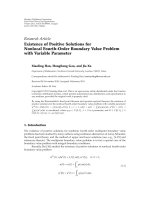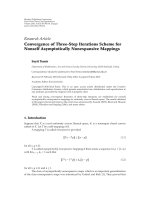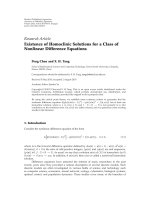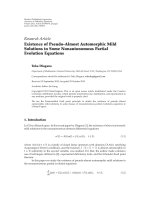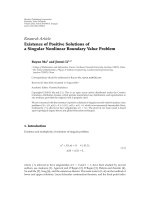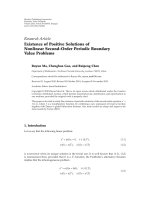Báo cáo hóa học: " Research Article Existence of Solutions and Nonnegative Solutions for Prescribed Variable Exponent Mean Curvature Impulsive System Initialized Boundary Value Problems" pot
Bạn đang xem bản rút gọn của tài liệu. Xem và tải ngay bản đầy đủ của tài liệu tại đây (517.73 KB, 13 trang )
Hindawi Publishing Corporation
Journal of Inequalities and Applications
Volume 2010, Article ID 915739, 13 pages
doi:10.1155/2010/915739
Research Article
Existence of Solutions and Nonnegative
Solutions for Prescribed Variable Exponent Mean
Curvature Impulsive System Initialized Boundary
Value Problems
Guizhen Zhi,
1
Liang Zhao,
2
Guangxia Chen,
3
Xiaopin Liu,
1
and Qihu Zhang
1, 4
1
Department of Mathematics and Information Science, Zhengzhou University of Light Industry,
Zhengzhou, Henan 450002, China
2
Academic Administration, Henan Institute of Science and Technology, Xinxiang, Henan 453003, China
3
School of Mathematics and Informatics, Henan Polytechnic University, Jiaozuo, Henan 454003, China
4
School of Mathematics and Statistics, Huazhong Normal University, Wuhan, Hubei 430079, China
Correspondence should be addressed to Qihu Zhang,
Received 10 May 2009; Accepted 23 January 2010
Academic Editor: Ond
ˇ
rej Dosly
Copyright q 2010 Guizhen Zhi et al. This is an open access article distributed under the Creative
Commons Attribution License, which permits unrestricted use, distribution, and reproduction in
any medium, provided the original work is properly cited.
This paper investigates the existence of solutions and nonnegative solutions for prescribed variable
exponent mean curvature impulsive system initialized boundary value problems. The proof of our
main result is based upon Leray-Schauder’s degree. The sufficient conditions for the existence of
solutions and nonnegative solutions have been given.
1. Introduction
The theory of impulsive differential equations describes processes which experience a
sudden change of their state at certain moments. On the Laplacian impulsive differential
equations boundary value problems, there are many results see 1–5. Because of the
nonlinearity of p-Laplacian, the results about p-Laplacian impulsive differential equations
boundary value problems are rare see 6.In7, 8, the authors discussed the existence
of solutions of pr-Laplacian system impulsive boundary value problems. Recently, the
existence and asymptotic behavior of solutions of curvature equations have been studied
extensively see 9–15.In16, the authors generalized the usual mean curvature systems
to variable exponent mean curvature systems. In this paper, we consider the existence of
2 Journal of Inequalities and Applications
solutions and nonnegative solutions for the prescribed variable exponent mean curvature
system
−
ϕ
r, u
f
r, u, u
0,r∈
0,T
,r
/
r
i
,
1.1
where u : 0,T → R
N
, with the following impulsive initialized boundary value condi-
tions
lim
r → r
i
u
r
− lim
r → r
−
i
u
r
A
i
lim
r → r
−
i
u
r
, lim
r → r
−
i
u
r
,i 1, ,k, 1.2
lim
r → r
i
ϕ
r, u
r
− lim
r → r
−
i
ϕ
r, u
r
B
i
lim
r → r
−
i
u
r
, lim
r → r
−
i
u
r
,i 1, ,k, 1.3
u
0
u
0
0, 1.4
where
ϕ
r, x
|
x
|
pr−1
x
1
|
x
|
qrpr
1/qr
, ∀r ∈
0,T
,x∈ R
N
,
1.5
p, q ∈ C0,T, R
are absolutely continuous, where p, q satisfy pr ≥ 1,qr ≥ 1,
−ϕr, u
is called the variable exponent mean curvature operator, 0 <r
1
<r
2
< ··· <
r
k
<Tand A
i
,B
i
∈ CR
N
× R
N
, R
N
.
For any v ∈ R
N
, v
j
will denote the jth component of v; the inner product in R
N
will be
denoted by ·, ·; |·|will denote the absolute value and the Euclidean norm on R
N
. Denote
that J 0,T, J
0,T \{r
0
,r
1
, ,r
k1
},andJ
0
r
0
,r
1
, J
i
r
i
,r
i1
, i 1, ,k, where
r
0
0, r
k1
T. Denote that J
o
i
is the interior of J
i
, i 0, 1, ,k.Let
PC
J, R
N
⎧
⎨
⎩
x : J −→ R
N
x ∈ C
J
i
, R
N
,i 0, 1, ,k,
lim
r → r
i
x
r
exists for i 1, ,k
⎫
⎬
⎭
,
PC
1
J, R
N
⎧
⎨
⎩
x ∈ PC
J, R
N
x
∈ C
J
o
i
, R
N
,
lim
r → r
i
x
r
and lim
r → r
−
i1
x
r
exist for i 0, 1, ,k
⎫
⎬
⎭
.
1.6
For any uru
1
r, ,u
N
r ∈ PCJ, R
N
, denote that |u
i
|
0
sup{|u
i
r||r ∈ J
}.
Obviously, PCJ, R
N
is a Banach space with the norm u
0
N
i1
|u
i
|
2
0
1/2
,andPC
1
J, R
N
is a Banach space with the norm u
1
u
0
u
0
. In the following, PCJ, R
N
and
PC
1
J, R
N
will be simply denoted by PC and PC
1
, respectively. Denote that L
1
L
1
J, R
N
,
and the norm in L
1
is u
L
1
N
i1
T
0
|u
i
r|dr
2
1/2
.
The study of differential equations and variational problems with variable exponent
conditions is a new and interesting topic. For the applied background on this kind of
problems we refer to 17–19. Many results have been obtained on this kind of problems,
Journal of Inequalities and Applications 3
for example, 20–35.Ifpr ≡ p a constant and qr ≡ q a constant, then 1.1 is the well-
known mean curvature system. Since problems with variable exponent growth conditions
are more complex than those with constant exponent growth conditions, many methods and
results for the latter are invalid for the former; for example, if Ω ⊂ R
n
is a bounded domain,
the Rayleigh quotient
λ
px
inf
u∈W
1,px
0
Ω\{0}
Ω
1/p
x
|
∇u
|
px
dx
Ω
1/p
x
|
u
|
px
dx
1.7
is zero in general, and only under some special conditions λ
px
> 0 see 25, but the fact
that λ
p
> 0 is very important in the study of p-Laplacian problems.
In this paper, we investigate the existence of solutions for the prescribed variable
exponent mean curvature impulsive differential system initialized boundary value problems;
the proof of our main result is based upon Leray-Schauder’s degree. This paper was
motivated by 6, 13, 36.
Let N ≥ 1, then the function f : J × R
N
× R
N
→ R
N
is assumed to be Caratheodory;
by this we mean that
i for almost every t ∈ J the function ft, ·, · is continuous,
ii for each x, y ∈ R
N
× R
N
the function f·,x,y is measurable on J,
iii for each R>0 there is a β
R
∈ L
1
J, R such that, for almost every t ∈ J and every
x, y ∈ R
N
× R
N
with |x|≤R, |y|≤R, one has
f
t, x, y
≤ β
R
t
. 1.8
We say a function u : J → R
N
is a solution of 1.1 if u ∈ PC
1
with ϕr, u
absolutely
continuous on J
o
i
, i 0, 1, ,k, which satisfies 1.1 a.e. on J.
This paper is divided into three sections; in the second section, we present some
preliminary. Finally, in the third section, we give the existence of solutions and nonnegative
solutions for system 1.1–1.4.
2. Preliminary
In this section, we will do some preparation.
Lemma 2.1 see 16. ϕ is a continuous function and satisfies the following.
i For any r ∈ J, ϕr, · is strictly monotone, that is,
ϕ
r, x
1
− ϕ
r, x
2
,x
1
− x
2
> 0, for any x
1
,x
2
∈ R
N
,x
1
/
x
2
.
2.1
ii For any fixed r ∈ J, ϕr, · is a homeomorphism from R
N
to
E
x ∈ R
N
|
|
x
|
< 1
. 2.2
4 Journal of Inequalities and Applications
For any r ∈ J, denote by ϕ
−1
r, · the inverse operator of ϕr, ·,then
ϕ
−1
r, x
1 −
|
x
|
qr
−1/prqr
|
x
|
1/pr−1
x, for x ∈ E \
{
0
}
,ϕ
−1
r, 0
0.
2.3
Let one now consider the following simple problem:
ϕ
r, u
r
h
r
,r∈
0,T
,r
/
r
i
,
2.4
with the following impulsive boundary value conditions:
lim
r → r
i
u
r
− lim
r → r
−
i
u
r
i
a
i
,i 1, ,k,
lim
r → r
i
ϕ
r, u
r
− lim
r → r
−
i
ϕ
r, u
r
b
i
,i 1, ,k,
u
0
u
0
0,
2.5
where a
i
,b
i
∈ R
N
,
k
i1
|b
i
| < 1; h ∈ L
1
.
Obviously, u
00 implies that ϕ0,u
0 0. If u is a solution of 2.4 with 2.5,by
integrating 2.4 from 0 to r, then one finds that
ϕ
r, u
r
r
i
<r
b
i
r
0
h
t
dt, ∀r ∈ J
.
2.6
Define a a
1
, ,a
k
∈ R
kN
,bb
1
, ,b
k
∈ R
kN
, and operator F : L
1
→ PC as
F
h
r
r
0
h
t
dt, ∀h ∈ L
1
.
2.7
From the definition of ϕ, one can see that
sup
r∈J
r
i
<r
b
i
F
h
r
< 1.
2.8
Denote that
D
b
h ∈ L
1
sup
r∈J
r
i
<r
b
i
F
h
r
< 1
.
2.9
By 2.6, one has
u
r
r
i
<r
a
i
F
ϕ
−1
r,
r
i
<r
b
i
F
h
r
, ∀r ∈ J.
2.10
Journal of Inequalities and Applications 5
Denote that W R
2kN
× L
1
with the norm
w
W
k
i1
|
a
i
|
k
i1
|
b
i
|
h
L
1
, ∀w
a, b, h
∈ W,
2.11
then W is a Banach space.
Let one define the nonlinear operator K
b
: D
b
→ PC
1
as
K
b
h
r
F
ϕ
−1
r,
r
i
<r
b
i
F
h
r
, ∀r ∈ J.
2.12
Lemma 2.2. The operator K
b
is continuous and sends closed equiintegrable subsets of D
b
into
relatively compact sets in PC
1
.
Proof. It is easy to check that K
b
h· ∈ PC
1
, for all h ∈ D
b
. Since
K
b
h
t
ϕ
−1
t,
r
i
<t
b
i
F
h
, ∀t ∈ J,
2.13
it is easy to check that K
b
is a continuous operator from D
b
to PC
1
.
Let now
U be a closed equiintegrable set in D
b
, then there exists η ∈ L
1
, such that, for
any u ∈
U,
|
u
t
|
≤ η
t
a.e. on J. 2.14
We want to show that
K
b
U ⊂ PC
1
is a compact set.
Let {u
n
} is a sequence in K
b
U, then there exists a sequence {h
n
}∈U such that
u
n
K
b
h
n
. For any t
1
,t
2
∈ J, we have that
|
F
h
n
t
1
− F
h
n
t
2
|
≤
t
2
t
1
η
t
dt
. 2.15
Hence the sequence {Fh
n
} is uniformly bounded and equicontinuous. By Ascoli-
Arzela theorem, there exists a subsequence of {Fh
n
} which we rename the same that is
convergent in PC. Then the sequence
ϕ
t, K
b
h
n
t
r
i
<t
b
i
F
h
n
2.16
is convergent according to the norm in PC. Since
K
b
h
n
t
F
ϕ
−1
t,
r
i
<t
b
i
F
h
n
t
, ∀t ∈ J,
2.17
6 Journal of Inequalities and Applications
according to the continuity of ϕ
−1
, we can see that K
b
h
n
is convergent in PC. Thus we
conclude that {u
n
} is convergent in PC
1
. This completes the proof.
We denote that N
f
u :PC
1
→ L
1
is the Nemytski operator associated to f defined by
N
f
u
r
f
r, u
r
,u
r
, a.e. on J. 2.18
Define K :PC
1
→ PC
1
as
K
u
r
F
ϕ
−1
r,
r
i
<r
B
i
F
N
f
u
r
, ∀r ∈ J,
2.19
where B
i
B
i
lim
r → r
−
i
ur, lim
r → r
−
i
u
r.
Lemma 2.3. u is a solution of 1.1–1.4 if and only if u is a solution of the following abstract
equation:
u
r
i
<r
A
i
K
u
,
2.20
where A
i
A
i
lim
r → r
−
i
ur, lim
r → r
−
i
u
r, B
i
B
i
lim
r → r
−
i
ur, and lim
r → r
−
i
u
r.
Proof. i If u is a solution of 1.1–1.4,sinceu
00 implies that ϕ0,u
0 0, by
integrating 1.1 from 0 to r, then we find that
ϕ
r, u
r
r
i
<r
B
i
r
0
f
t, u, u
dt, ∀r ∈ J
.
2.21
Thus
u
r
i
<r
A
i
K
u
.
2.22
Hence u is a solution of 2.20.
ii If u is a solution of 2.20, then it is easy to see that 1.2 is satisfied. Let r 0, then
we have
u
0
0. 2.23
From 2.20 we also have
ϕ
r, u
r
i
<r
B
i
F
N
f
u
r
,r∈
0,T
,r
/
r
i
,
2.24
ϕr, u
f
r, u, u
,r∈
0,T
,r
/
r
i
.
2.25
Journal of Inequalities and Applications 7
From 2.24, we can see that 1.3 is satisfied. Let r 0, from 2.24, then we have
ϕ
0,u
0
0. 2.26
Since ϕr, x|x|
pr−1
x/1 |x|
qrpr
1/qr
0, we must have x 0; thus,
u
0
0. 2.27
Hence u is a solution of 1.1–1.4. This completes the proof.
3. Main Results and Proofs
In this section, we will apply Leray-Schauder’s degree to deal with the existence of solutions
for 1.1–1.4.
We assume that
H
0
k
i1
|B
i
u, v| < 1/2, for all u, v ∈ R
N
× R
N
.
Theorem 3.1. If (H
0
) is satisfied, then 0 ∈ Ω is an open bounded set in PC
1
such that the following
conditions hold.
1
0
For any u ∈ Ω, the mapping r → fr, u, u
belongs to {v ∈ L
1
|v
L
1
< 1/3}.
2
0
For each λ ∈ 0, 1, the problem
ϕ
r, u
λf
r, u, u
,r∈
0,T
,r
/
r
i
,
lim
r → r
i
u
r
− lim
r → r
−
i
u
r
λA
i
lim
r → r
−
i
u
r
, lim
r → r
−
i
u
r
,i 1, ,k,
lim
r → r
i
ϕ
r, u
r
− lim
r → r
−
i
ϕ
r, u
r
λB
i
lim
r → r
−
i
u
r
, lim
r → r
−
i
u
r
,i 1, ,k,
u
0
u
0
0
3.1
has no solution on ∂Ω.
Then 1.1–1.4 has at least one solution on
Ω.
Proof. Denote that
A
i
A
i
lim
r → r
−
i
u
r
, lim
r → r
−
i
u
r
,B
i
B
i
lim
r → r
−
i
u
r
, lim
r → r
−
i
u
r
. 3.2
For any λ ∈ 0, 1, define K
λ
:PC
1
→ PC
1
as
K
λ
u
r
F
ϕ
−1
r,
r
i
<r
λB
i
F
λN
f
u
r
, ∀r ∈ J.
3.3
Denote that Ψu, λ : λ
r
i
<r
A
i
K
λ
u.
8 Journal of Inequalities and Applications
We know that 1.1–1.4 has the same solutions of
u Ψ
u, 1
r
i
<r
A
i
K
1
u
.
3.4
Since f is Caratheodory, it is easy to see that N
f
· is continuous and sends bounded
sets into equiintegrable sets. According to Lemma 2.2, we can conclude that Ψ is compact
continuous on
Ω for any λ ∈ 0, 1. We assume that for λ 1 3.4 does not have a solution on
∂Ω; otherwise, we complete the proof. Now from hypothesis 2
0
, it follows that 3.4 has no
solution for u,λ ∈ ∂Ω × 0, 1.
When λ 0, 3.1 is equivalent to the following usual problem:
−
ϕ
r, u
0,u
0
u
0
0,
3.5
where obviously 0 is the unique solution to this problem.
Since 0 ∈ Ω, we have proved that 3.4 has no solution u,λ on ∂Ω×0, 1, then we get
that, for each λ ∈ 0, 1, Leray-Schauder’s degree d
LS
I − Ψ·,λ, Ω, 0 is well defined. From
the homotopy invariant property of that degree, we have
d
LS
I − Ψ
u, 1
, Ω, 0
d
LS
I − Ψ
u, 0
, Ω, 0
1. 3.6
This completes the proof.
In the following, we will give an application of Theorem 3.1.
Denote that σ 4T/4T 1 and
Ω
ε
u ∈ PC
1
max
1≤j≤N
u
j
0
u
j
0
<ε
.
3.7
Obviously, Ω
ε
is an open subset of PC
1
.
Assume that
H
1
fr, u, vδgr, u, v, where δ is a positive parameter, and g is Caratheodory.
H
2
k
i1
|A
i
u, v|≤ σ/2ε,
k
i1
|B
i
u, v|≤{min
r∈I
|ε/4T 1|
pr
/21|Nε|
qrpr
1/qr
,
1/2}, for all u, v ∈ R
N
× R
N
.
Theorem 3.2. If H
1
-H
2
are satisfied, then problem 1.1–1.4 has at least one solution on Ω
ε
,
when positive parameter δ is small enough.
Proof. Let one consider the problem
u Ψ
u, λ
λ
r
i
<r
A
i
K
λ
u
,
3.8
where K
λ
· is defined in 3.3.
Journal of Inequalities and Applications 9
Obviously, u is a solution of 1.1–1.4 if and only if u is a solution of the abstract
equation 3.8 when λ 1. We only need to prove that the conditions of Theorem 3.1 are
satisfied.
1
0
When positive parameter δ is small enough, for any u ∈ Ω
ε
, we can see that the
mapping r → δgr, u, u
belongs to {u ∈ L
1
|u
L
1
< 1/3}.
2
0
We shall prove that for each λ ∈ 0, 1 the problem
ϕ
r, u
λf
r, u, u
,r∈
0,T
,r
/
r
i
,
lim
r → r
i
u
r
− lim
r → r
−
i
u
r
λA
i
lim
r → r
−
i
u
r
, lim
r → r
−
i
u
r
,i 1, ,k,
lim
r → r
i
ϕ
r, u
r
− lim
r → r
−
i
ϕ
r, u
r
λB
i
lim
r → r
−
i
u
r
, lim
r → r
−
i
u
r
,i 1, ,k,
u
0
u
0
0
3.9
has no solution on ∂Ω
ε
.
If it is false, then there exists a λ ∈ 0, 1 and u ∈ ∂Ω
ε
is a solution of 3.8. Then there
exists an j ∈{1, ,N} such that |u
j
|
0
|u
j
|
0
ε.
i Suppose that |u
j
|
0
≥ σε, then |u
j
|
0
≤ 1 − σε. For any r ∈ J, since u00,
according to H
2
and 1.2, we have
u
j
r
u
j
r
− u
j
0
r
0
u
j
t
dt
0<r
i
<r
A
i
≤
T
0
u
j
t
dt
0<r
i
<r
|
A
i
|
≤
T
0
1 − σ
εdr
k
i1
|
A
i
|
≤
σ
4
ε
σ
2
ε
3σ
4
ε.
3.10
It is a contradiction.
ii Suppose that |u
j
|
0
<σε, 1−σε<|u
j
|
0
≤ ε. This implies that |u
j
r
∗
| > 1−σε
1/4T 1ε for some r
∗
∈ J.
Denote that
ϕ
j
r, u
r
|
u
|
pr−1
u
j
r
1
|
u
|
qrpr
1/qr
.
3.11
10 Journal of Inequalities and Applications
Since u
00, we have
ϕ
j
r
∗
,u
r
∗
λ
r
∗
0
f
j
r, u, u
dr λ
0<r
i
<r
∗
B
j
i
.
3.12
According to H
1
-H
2
, when positive parameter δ is small enough, we have
|
ε/4T 1
|
pr
∗
1
|
Nε
|
qr
∗
pr
∗
1/qr
∗
≤
ϕ
j
r
∗
,u
r
∗
≤ λ
r
∗
0
f
j
r, u, u
dr λ
0<r
i
<r
∗
B
j
i
≤ δ
T
0
β
Nε
r
dr
k
i1
|
B
i
|
<
|
ε/4T 1
|
pr
∗
1
|
Nε
|
qr
∗
pr
∗
1/qr
∗
.
3.13
It is a contradiction.
Summarizing this argument, for each λ ∈ 0, 1, the problem 3.8 with 1.4 has no
solution on ∂Ω
ε
.
Since 0 ∈ Ω
ε
and 0 is the unique solution of u Ψu, 0, then the Leray-Schauder’s
degree
d
LS
I − Ψ
·, 0
, Ω, 0
1
/
0. 3.14
This completes the proof.
In the following, we will discuss the existence of nonnegative solutions of 1.1–1.4.
For any x {x
1
, ,x
N
}∈R
N
, the notation x ≥ 0 x>0 means that x
l
≥ 0 x
l
> 0 for every
l ∈{1, ,N}.
Assume the following
H
3
fr, u, vδgr, u, v, where δ is a positive parameter, and
g
r, u, v
τ
r
|
u
|
q
1
r−1
u μ
r
|
v
|
q
2
r−1
v
γ
r
, 3.15
where q
1
,q
2
∈ CJ, R, 0 ≤ q
1
r,and0≤ q
2
r, for all r ∈ J.
H
4
A
j
i
x, yy
j
≥ 0, and B
j
i
x, yy
j
≥ 0, for all x, y ∈ R
N
,i 1, ,k, j 1, ,N.
H
5
μ, τ ∈ CJ, R
.
H
6
γ γ
1
, ,γ
N
∈ CJ, R
N
satisfies γ0 > 0,
t
0
γsds ≥ 0, for all t ∈ 0,T.
Theorem 3.3. If H
2
–H
6
are satisfied, then the problem 1.1–1.4 has a nonnegative solution,
when positive parameter δ is small enough.
Journal of Inequalities and Applications 11
Proof. From Theorem 3.2, we can get the existence of solutions of 1.1–1.4 .Ifu is a solution
of 1.1–1.4, according to 1.4 and H
6
, then we have
f
0,u
0
,u
0
δγ
0
> 0. 3.16
Obviously
ϕ
r, u
r
r
0
δ
τ
r
|
u
|
q
1
r−1
u μ
r
u
q
2
r−1
u
γ
r
ds, ∀r ∈
0,r
1
.
3.17
When r → 0
, we have
τ
r
|
u
|
q
1
r−1
u μ
r
u
q
2
r−1
u
γ
r
> 0, 3.18
then we can see that there exists a ξ ∈ 0,r
1
such that ϕr, u
r > 0 when r ∈ 0,ξ.Thus
u
r > 0 for any r ∈ 0,ξ.Thusur is increasing in 0,ξ,thatis,uη
2
≥ uη
1
for any
η
1
,η
2
∈ 0,ξ with η
1
<η
2
. Since u00, it is easy to see that ur > 0 for any r ∈ 0,ξ.From
3.17 and H
5
, we can easily see that
u
r
> 0,u
r
> 0, ∀r ∈
0,r
1
,
lim
r → r
−
1
u
r
> 0, lim
r → r
−
1
u
r
> 0.
3.19
From H
4
, we can see that
lim
r → r
1
u
r
> 0, lim
r → r
1
u
r
> 0.
3.20
Similarly, we can see that
u
r
> 0,u
r
> 0, ∀r ∈
r
1
,r
2
. 3.21
Repeating the step, we can see that
u
r
> 0,u
r
> 0, ∀r ∈ J
. 3.22
Hence u is nonnegative. This completes the proof.
Acknowledgments
This paper is partly supported by the National Science Foundation of China 10701066,
10926075 and 10971087, China Postdoctoral Science Foundation funded project
20090460969, the Natural Science Foundation of Henan Education Committee 2008-755-
65, and the Natural Science Foundation of Jiangsu Education Committee 08KJD110007.
12 Journal of Inequalities and Applications
References
1 J. Jiao, L. Chen, and L. Li, “Asymptotic behavior of solutions of second-order nonlinear impulsive
differential equations,” Journal of Mathematical Analysis and Applications, vol. 337, no. 1, pp. 458–463,
2008.
2 L. Liu, L. Hu, and Y. Wu, “Positive solutions of two-point boundary value problems for systems
of nonlinear second-order singular and impulsive differential equations,” Nonlinear Analysis: Theory,
Methods & Applications, vol. 69, no. 11, pp. 3774–3789, 2008.
3 X. Liu and D. Guo, “Periodic boundary value problems for a class of second-order impulsive integro-
differential equations in Banach spaces,” Journal of Mathematical Analysis and Applications, vol. 216, no.
1, pp. 284–302, 1997.
4 J. Shen and W. Wang, “Impulsive boundary value problems with nonlinear boundary conditions,”
Nonlinear Analysis: Theory, Methods & Applications, vol. 69, no. 11, pp. 4055–4062, 2008.
5 M. Yao, A. Zhao, and J. Yan, “Periodic boundary value problems of second-order impulsive
differential equations,” Nonlinear Analysis: Theory, Methods & Applications, vol. 70, no. 1, pp. 262–273,
2009.
6 A. Cabada and J. Tome
ˇ
cek, “Extremal solutions for nonlinear functional φ-Laplacian impulsive
equations,” Nonlinear Analysis: Theory, Methods & Applications, vol. 67, no. 3, pp. 827–841, 2007.
7 Q. Zhang, X. Liu, and Z. Qiu, “Existence of solutions for weighted pr-Laplacian impulsive system
periodic-like boundary value problems,” Nonlinear Analysis: Theory, Methods & Applications, vol. 71,
no. 9, pp. 3596–3611, 2009.
8 Q. Zhang, Z. Qiu, and X. Liu, “Existence of solutions and nonnegative solutions for weighted
pr-Laplacian impulsive system multi-point boundary value problems,” Nonlinear Analysis: Theory,
Methods & Applications, vol. 71, no. 9, pp. 3814–3825, 2009.
9 R. Filippucci, “Entire radial solutions of elliptic systems and inequalities of the mean curvature type,”
Journal of Mathematical Analysis and Applications, vol. 334, no. 1, pp. 604–620, 2007.
10 A. Greco, “On the existence of large solutions for equations of prescribed mean curvature,” Nonlinear
Analysis: Theory, Methods & Applications, vol. 34, no. 4, pp. 571–583, 1998.
11 N. M. Ivochkina, “The Dirichlet problem for the curvature equation of order m,”
Leningrad
Mathematical Journal, vol. 2, pp. 631–654, 1991.
12 K. E. Lancaster and D. Siegel, “Existence and behavior of the radial limits of a bounded capillary
surface at a corner,” Pacific Journal of Mathematics, vol. 176, no. 1, pp. 165–194, 1996.
13 H. Pan, “One-dimensional prescribed mean curvature equation with exponential nonlinearity,”
Nonlinear Analysis: Theory, Methods & Applications, vol. 70, no. 2, pp. 999–1010, 2009.
14 K. Takimoto, “Solution to the boundary blowup problem for k-curvature equation,” Calculus of
Variations and Partial Differential Equations, vol. 26, no. 3, pp. 357–377, 2006.
15 N. S. Trudinger, “The Dirichlet problem for the prescribed curvature equations,” Archive for Rational
Mechanics and Analysis, vol. 111, no. 2, pp. 153–179, 1990.
16 Q. Zhang, Z. Qiu, and X. Liu, “Existence of solutions for prescribed variable exponent mean curvature
system boundary value problems,” Nonlinear Analysis: Theory, Methods & Applications, vol. 71, no. 7-8,
pp. 2964–2975, 2009.
17 Y. Chen, S. Levine, and M. Rao, “Variable exponent, linear growth functionals in image restoration,”
SIAM Journal on Applied Mathematics, vol. 66, no. 4, pp. 1383–1406, 2006.
18 M. R
˚
u
ˇ
zi
ˇ
cka, Electrorheological Fluids: Modeling and Mathematical Theory, vol. 1748 of Lecture Notes in
Mathematics, Springer, Berlin, Germany, 2000.
19 V. V. Zhikov, “Averaging of functionals of the calculus of variations and elasticity theory,” Mathematics
of the USSR. Izvestiya, vol. 29, pp. 33–36, 1987.
20 X L. Fan, H Q. Wu, and F Z. Wang, “Hartman-type results for pt-Laplacian systems,” Nonlinear
Analysis: Theory, Methods & Applications, vol. 52, no. 2, pp. 585–594, 2003.
21 X L. Fan and D. Zhao, “Regularity of minimum points of variational integrals with continuous px-
growth conditions,” Chinese Annals of Mathematics. Series A, vol. 17, no. 5, pp. 557–564, 1996.
22 X L. Fan and D. Zhao, “On the spaces L
px
Ω and W
m,px
Ω,” Journal of Mathematical Analysis and
Applications, vol. 263, no. 2, pp. 424–446, 2001.
23 X L. Fan and Q H. Zhang, “Existence of solutions for px-Laplacian Dirichlet problem,” Nonlinear
Analysis: Theory, Methods & Applications, vol. 52, no. 8, pp. 1843–1852, 2003.
24 X L. Fan, Y. Z. Zhao, and Q. H. Zhang, “A strong maximum principle for px-Laplace equations,”
Chinese Journal of Contemporary Mathematics, vol. 24, no. 4, pp. 495–500, 2003.
Journal of Inequalities and Applications 13
25 X L. Fan, Q. H. Zhang, and D. Zhao, “Eigenvalues of px-Laplacian Dirichlet problem,” Journal of
Mathematical Analysis and Applications, vol. 302, no. 2, pp. 306–317, 2005.
26 A. El Hamidi, “Existence results to elliptic systems with nonstandard growth conditions,” Journal of
Mathematical Analysis and Applications, vol. 300, no. 1, pp. 30–42, 2004.
27 O. Kov
´
a
ˇ
cik and J. R
´
akosn
´
ık, “On spaces L
px
Ω and W
k,px
Ω,” Czechoslovak Mathematical Journal,
vol. 41, no. 4, pp. 592–618, 1991.
28 P. Marcellini, “Regularity and existence of solutions of elliptic equations with p, q-growth
conditions,” Journal of Differential Equations, vol. 90, no. 1, pp. 1–30, 1991.
29 M. Mih
˘
ailescu and V. R
˘
adulescu, “Continuous spectrum for a class of nonhomogeneous differential
operators,” Manuscripta Mathematica, vol. 125, no. 2, pp. 157–167, 2008.
30 J. Musielak, Orlicz Spaces and Modular Spaces, vol. 1034 of Lecture Notes in Mathematics, Springer, Berlin,
Germany, 1983.
31 S. G. Samko, “Density C
∞
0
R
N
in the generalized Sobolev spaces W
m,px
R
N
,” Doklady Akademii
Nauk. Rossi
˘
ıskaya Akademiya Nauk, vol. 369, no. 4, pp. 451–454, 1999.
32 Q. H. Zhang, “A strong maximum principle for differential equations with nonstandard px-growth
conditions,” Journal of Mathematical Analysis and Applications, vol. 312, no. 1, pp. 24–32, 2005.
33 Q. H. Zhang, “Existence of solutions for px-Laplacian equations with singular coefficients in
R
N
,”
Journal of Mathematical Analysis and Applications, vol. 348, no. 1, pp. 38–50, 2008.
34 Q. Zhang, X. Liu, and Z. Qiu, “The method of subsuper solutions for weighted pr-Laplacian
equation boundary value problems,” Journal of Inequalities and Applications, vol. 2008, Article ID
621621, 18 pages, 2008.
35 Q. Zhang, Z. Qiu, and X. Liu, “Existence of solutions for a class of weighted pt-Laplacian system
multipoint boundary value problems,” Journal of Inequalities and Applications, vol. 2008, Article ID
791762, 18 pages, 2008.
36 R. Man
´
asevich and J. Mawhin, “Periodic solutions for nonlinear systems with p-Laplacian-like
operators,” Journal of Differential Equations, vol. 145, no. 2, pp. 367–393, 1998.




